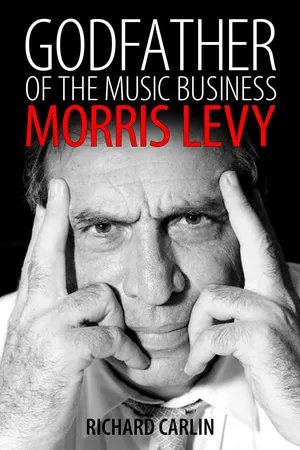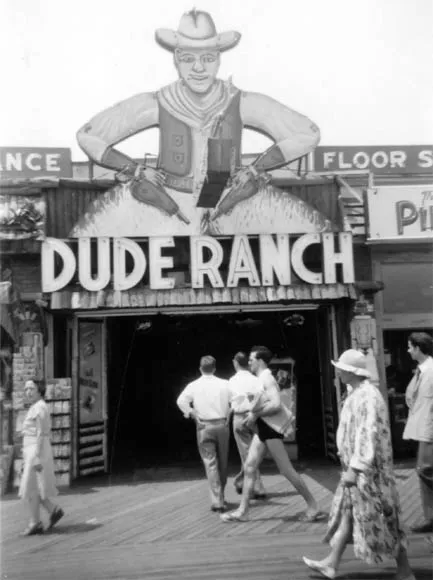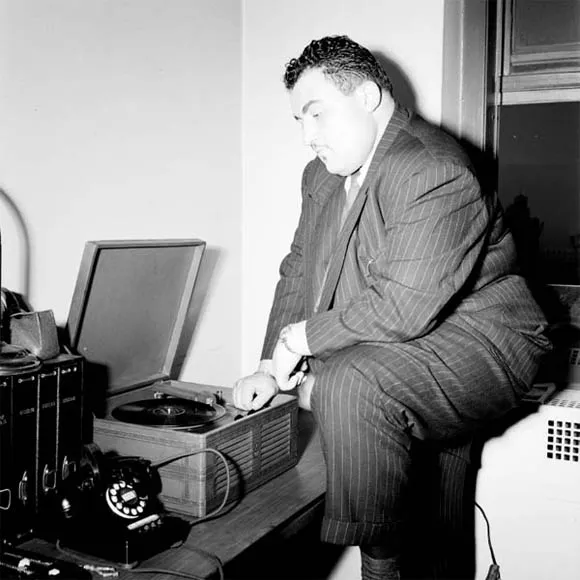![]()
1
Beginnings: From the Bronx to the Royal Roost
I was smart, I was hard-working, and I was a tough kid.
—Morris Levy
Morris Levy was born to a working-class Jewish family in New York City’s Harlem on August 27, 1927. His father, Simon Levy, was originally from Greece and immigrated to the United States in 1912; he was preceded by a brother, Morris, who came in 1909 and settled in Brooklyn.1 Simon may have joined his brother Morris in operating a small grocery in Brooklyn. In March 1921, Simon wed the former Rachel Rodrigues, who was born on May 18, 1896, in Andrinople, Turkey, and came to the United States in November 1919.2 A son named Zachariah (named for Simon’s father, he was later known as Irving) was born on December 3, 1922, followed by another child (who died before Morris’s birth), and finally by Morris five years later. However, tragedy struck soon after when Simon died of pneumonia in 1928, a disease that regularly ravaged the slums of New York in the early twentieth century. Simon’s brother Morris had four children himself, so he may not have been able to offer any aid to Rachel or her family.
Following Simon’s death, the family moved to the Bronx. According to Morris, his mother was ill-equipped to support him and his brother; Zachariah was temporarily placed in an orphanage while Rachel Levy struggled to cope.3 Rachel suffered from an assortment of ailments, including such severe lockjaw that she had to have her front teeth removed in order to eat,4 and thus was unable to hold a regular job. Initially she worked as a sewing machine operator, a common occupation for first-generation Jews in the city. However, as she became increasingly disabled, she found work on a piecemeal basis, cleaning apartments and doing chores. Her two sons were mostly left to fend for themselves.5
Like many other immigrant families during the Depression years, the Levys were driven onto relief, a source of embarrassment to the young man. “When we got the [welfare] check on the first of the month,” he boasted years later, “I used to mail it back to the state, or the city, or whoever the fuck it was.”6 (This is highly unlikely, as no family was in a position to turn down aid, particularly the Levys.) Desperate to be self-sufficient, he began shining shoes at the age of nine. Like many others, he found school boring and a waste of time when he really wanted to be supporting himself and his impoverished mother.7 By the mid-thirties the family was living in a small apartment in a tenement in the West Bronx. At age seventeen Zachariah was working as a printer’s apprentice, having dropped out of school after completing the sixth grade.8
When Levy hit adolescence, he had already achieved a formidable physique: he was tall (nearly six feet) and muscular. Levy managed to stay in school through at least junior high school.9 However, the tipping point for him came when he experienced what he considered to be a grave injustice. Although he did well on a math test, the teacher required the entire class—most of whom had failed the exam—to spend their homeroom time doing extra math work. Still bitter decades later, Levy said this teacher “had no business teaching school. [She] . . . must have been seventy-five years old, never got fucked in her life.” After she demanded that all be punished because of the poor performance of a few, Levy challenged her, asking, “What about those who passed the test?” According to him:
She looks at me and says, “Levy, you’re a troublemaker. I’m gonna get you out of this classroom if I have to take your family off home relief.” And I got up—I was a big kid—took her wig off her head, poured an inkwell on her bald head, and put her wig back on her fucking head. Walked out of school and said, “Fuck school.” Never really went back to school after that. I was sentenced to eight years to [reform school] by the children’s court . . . This bitch had no fucking humanity.10
In another telling of his story, Levy said that following this incident he ran away from home to Florida to avoid serving time in juvenile detention. He claimed to have effectively covered his tracks by getting “my school records destroyed. I had someone apply for a transfer to another school, and the old school gave them my records to take to the new school—and they made them disappear. So I disappeared as a student in the U.S.”11 Whether Levy was so well connected as a teenager that he could pull off this stunt is unknown; but in any case he never completed his formal education, seeing little value in kowtowing to tyrants like this teacher.
While in Florida, Levy may have landed his first job working in a nightclub. At the time, nightclubs were mainly financed and controlled by “criminal elements” that kept a hand in every level of their operation, from the checking of hats and coats to the serving of drinks to the booking of entertainment. A common entry-level position for a young man on the make was to serve as a hatcheck boy. Prior to the early twentieth century, men kept their coats and hats with them on the backs of their chairs or on wall hooks. The idea of checking your hat at the door was unknown until an enterprising individual—different names have been floated for the man who first came up with the idea12—approached one of New York’s tonier restaurants and suggested that, in return for paying an annual fee, he would operate a hatcheck concession for them. All he asked for in return was the ability to collect tips from the patrons. Even though the initial concession fees were in the $2,000–$3,000 range, and tips were in the range of a dime or so per customer, the profits were enormous and various groups—both legitimate and semi-legitimate—began bidding for control of these concessions in every major U.S. city.
According to a 1911 article in the New York Times, hatcheck boys could earn a pretty good wage and were given other perks, including dress uniforms—although the concessionaires had special reason to insist that they wear these pocketless outfits:
The [hatcheck concessionaires] . . . employ ignorant Greek boys and sometimes Russians [i.e., Jews], because they are cheap and cheeky. They get from $25 to $30 a month, with their uniforms, and the Captain, who has a confidential job, gets $60 a month and sometimes a small share of the profits. The clothing of the boys is made without pockets, so that they cannot conceal any money they receive and the duty of the Captain is to keep a lookout and see that they do not hide coins away in their shoes, under the carpet, or any other likely place of concealment to the detriment of his employer.13
An enterprising hatchecker could work his way up from cloakroom boy to captain to being his own boss through scraping and saving (as well as the occasional pocketing of tips). And Levy was enterprising; by age fourteen he was working his way up the hatcheck ladder.
After working in the checkrooms, Levy graduated to working in another semi-legitimate business that flourished in New York’s nightspots: darkroom boy. His first job was the at the Ubangi club, when he was sixteen. He relates: “The camera girls would go around clubs taking flash photos. You were in a room in the back of the club, and you got the negatives, and you developed ’em and had ’em ready in 15 minutes for the customers.”14
Even as a teenager, Levy was well aware of who the true powerbrokers were in the clubs: “When I was 14 or 15 I worked for people that were in the Mob because they were the people that owned the clubs. They liked me because I was smart, I was hard-working, and I was a tough kid.”15 Levy noted that the fact that he “associated” with mobsters was hardly unusual; their presence as nightclub operators was universally acknowledged, and winning their favor was the way a smart young man could get ahead: “In those days, even the judges and politicians would kiss [the mobsters’] ass. . . . They’d want to be seen with these guys. If you wanted to be somebody, you came in contact with them.”16 It was during this time that Levy probably met Morris Gurlek,17 who had his own concession business.18 Gurlek remained a personal mentor and financier for many of Levy’s projects until his death in 1970.
Entrance to Atlantic City’s Dude Ranch, August, 1948. Note how you would enter through the cowboy’s legs! This is one of the clubs where Levy helped manage photo and hatcheck concessions, in the period 1946–48.
Being street smart and tough were key qualifications for a young man working his way up from the very bottom. Levy possessed these skills by the boatload, and impressed his bosses with his work ethic:
I became good at the darkroom. I advanced with the people who I worked for and became a head guy, setting up darkrooms around the country. We had the rights to a lot of clubs. In Atlantic City, there was Babette’s, the Dude Ranch, the Chateau Renault. In Philadelphia, there was the Walton Roof, the Rathskeller, Frank Colombo’s. In Newark, it was the Hourglass; in Miami there was places like the 600 Club, the Frolics Club, the 5 O’Clock Club. New York itself had two hundred nightclubs, probably.19
Teddy Reig, ca. 1948, when he was working as a producer for Savoy Records. Photograph by William Gottlieb, courtesy the William Gottlieb collection/Library of Congress.
Many of these clubs had notorious reputations and were regular targets of law enforcement. Their activities present a veritable checklist of criminal and semi-criminal activities. Babette’s, operated by Dan Stebbins and named for his wife who led the floor show, was a target of a federal probe into illegal gambling in the 1930s;20 it featured a yacht-shaped bar and a “trapdoor [leading to] the roof and a descending stairway for quick getaways.”21 The colorful Dude Ranch featured a huge, thirty-foot tall cutout of a cowboy on its façade; guests entered by walking through its legs.22 The Rathskeller was the subject of several raids, in 1945 for employing underage bartenders and a year later for presenting an “obscene” act.23 The FBI claimed that Miami’s Frolics Club was operated by notorious Jewish gangsters Morris Barney Dalitz (a.k.a. Moe Davis) and Louis Buchalater, who ran illegal gambling operations in nightclubs across the country from their base in Cleveland, Ohio.24 Levy’s education involved interacting with this entire cast of characters, many of whom served as informal role models for his later business dealings.
Levy’s progress up the nightclub career ladder was temporarily interrupted—as was the case for many in his generation—by World War II. Perhaps in anticipation of his eighteenth birthday exposing him to the draft, Levy enlisted in the navy in March 1945 and went on active duty a month later working as a hospital apprentice on Long Island. (Levy’s brother Irving also served in the navy, enlisting earlier in the war.) His service ended after only five months when he received an honorable discharge because of “the dependency of [his] ill mother.”25 All in all, Morris avoided the danger of going overseas, and could still maintain his contacts in New York City while he was in service.
During the war, servicemen on leave flooded New York City, seeking entertainment of all kinds. Clubs that had been struggling to survive were suddenly minting money. As Teddy Reig—a self-described “jazz hustler”—recalled: “The fleets would dock and the sailor and army guys were all over. Add to them everybody else who had made it here by bus or rail, and the locals were ready for them. It was a place to score, to make a living. You could get any f—king thing, do any f—king thing. The music was the icing on the cake, but for that you had to go to 52nd Street.”26
It was a boom time for everyone who fed off of the nightclubs, from operators like Reig to musicians like the you...


